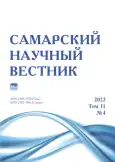The influence of the Sayano-Shushenskaya Dam reservoir on the nesting and abundance of the osprey (Pandion haliaetus L., 1758)
- Authors: Shikalova E.A.1,2
-
Affiliations:
- United Directorate of Sayano-Shushensky State Nature Biosphere Reserve and Shushensky Bor National Park
- Katanov Khakass State University
- Issue: Vol 11, No 4 (2022)
- Pages: 136-139
- Section: Biological Sciences
- URL: https://journals.rcsi.science/2309-4370/article/view/133230
- DOI: https://doi.org/10.55355/snv2022114120
- ID: 133230
Cite item
Full Text
Abstract
The paper presents the materials of the study of the osprey grouping on the territory of the Sayano-Shushensky Nature Reserve. Before the formation of the reservoir, 3–4 osprey nests were recorded on the banks of the Yenisei. The flooding of the valley was accompanied by the formation of extensive flat areas suitable for nesting. The volume of fish resources that form the basis of the osprey’s food supply has increased and their availability is one of the main criteria of the ecosystem, on which the number of this rare bird depends. Continuous monitoring of the osprey grouping on the shores of the Sayano-Shushenskaya Dam reservoir within the Sayano-Shushensky Nature Reserve began in 2012. The work included a survey of suitable habitats in order to identify nesting sites, certification of nests, accounting of adult birds, as well as monitoring the reproduction of ospreys. Based on the results of the research, it was possible to create a model of optimal natural conditions for nesting ospreys in the mountainous regions of Siberia. The creation of a large artificial reservoir has had a positive impact on the number of protected groups of ospreys. A special regime of strict protection peculiar to biosphere reserves plays a positive role, which excludes visits to nest bays, significantly reducing the anxiety factor. Together, this allows the birds to expand the nesting areas and breed offspring.
Full Text
##article.viewOnOriginalSite##About the authors
Elena Alekseevna Shikalova
United Directorate of Sayano-Shushensky State Nature Biosphere Reserve and Shushensky Bor National Park; Katanov Khakass State University
Author for correspondence.
Email: e.shikalova@mail.ru
deputy director for scientific work, postgraduate student of Biology Department
Russian Federation, Shushenskoe, Krasnoyarsk Krai; AbakanReferences
- Летопись природы Саяно-Шушенского заповедника за 2021 г. Шушенское, 2022. Т. 44. 319 с.
- Шикалова Е.А., Виноградов В.В. Современное состояние группировки скопы на территории Саяно-Шушенского биосферного заповедника и его охранной зоны // Вестник ИрГСХА. 2021. Вып. 104. С. 107–119. doi: 10.51215/1999-3765-2021-104-107-119.
- Афанасьев Р.Г., Линейцев С.Н., Лукаревский В.С., Сонникова А.Е., Шикалова Е.А. Мониторинг природных процессов и многолетние ряды наблюдений в Саяно-Шушенском заповеднике // Вопросы географии. 2017. № 143. С. 286–309.
- Шикалова Е.А., Виноградов В.В. Гнездование скопы (Pandion haliaetus) на территории Саяно-Шушенского биосферного заповедника и его охранной зоны за период 2012–2017 гг. // Мониторинг состояния природных комплексов и многолетние исследования на особо охраняемых природных территориях. 2018. № 2. С. 110–126.
- Стахеев В.А. О гнездовании скопы при формировании Саянского водохранилища // Изучение птиц СССР: их охрана и рациональное использование: тез. докл. I съезда всесоюз. орнитол. об-ва и IX Всесоюз. орнитол. конф., 16–20 дек. 1986 г. Л.: ЗИН, 1986. С. 257–258.
- Петров С.Ю. Птицы Саяно-Шушенского заповедника. Абакан, 2014. 211 с.
- Петров С.Ю., Чумаков С.В. Птицы национального парка «Шушенский бор». Шушенское, 2020. 490 с.
- Стахеев В.А. Скопа в Алтайском и Саяно-Шушенском заповедниках // Охрана хищных птиц. М., 1986. С. 159–161.
- Карякин И.В. Скопа в Алтае-Саянском экорегионе // Пернатые хищники и их охрана. Спецвып. 1. 2018. С. 172–175.
- Кузнецов А. Скопа – птица 2018 года // Мир птиц. 2018. № 9–50. С. 2–7.
- Саурола П. Скопы Финляндии с 1971 по 2017 годы: изучение и охрана // Пернатые хищники и их охрана. 2018. Спецвып. 1. С. 150–152.
- Селлис У., Кальванс А. Скопа в Эстонии и Латвии. Обзор // Пернатые хищники и их охрана. 2018. Спецвып. 1. С. 156–157.
- Бабушкин М.В., Кузнецов А.В. Современная численность и распространение скопы на побережьях крупных водоемов северо-запада России // Пернатые хищники и их охрана. 2018. Спецвып. 1. С. 158–161.
- Баранов А.А. Птицы Алтай-Саянского экорегиона: пространственно-временная динамика биоразнообразия: монография. Т. 1. Красноярск: Краснояр. гос. пед. ун-т им. В.П. Астафьева, 2012. 464 с.
- Скопа Pandion haliaetus L., 1758 // Красная книга Красноярского края: Редкие и находящиеся под угрозой исчезновения виды животных. Т. 1. Красноярск, 2012. С. 69.
- Кузнецов А.В., Немцев В.В. История формирования и современное состояние популяций скопы Pandion haliaetus и орлана-белохвоста Haliaeetus albicilla на Рыбинском и Шекснинском водохранилищах // Русский орнитологический журнал. 2011. Т. 20, экспресс-выпуск 637. С. 444–446.
- Рябицев В.К. Птицы Урала, Приуралья и Западной Сибири: справочник-определитель. Екатеринбург: Изд-во Урал. ун-та, 2001. 608 с.
- Пчелинцев В.Г., Бабушкин М.В., Кузнецов А.В. Распределение и численность орлана-белохвоста и скопы на северо-западе России // Вестник Санкт-Петербургского университета. Сер. 3. 2010. Вып. 1. С. 9–14.
- Babushkin M.V. Species diversity, population and ecology of raptors on the northeastern shore of the Rybinsk reservoir // Status of raptor population in Eastern Fennoscandia: proceedings of the workshop, Kostomuksha, Karelia, Russia, November 8–10, 2005. Petrozavodsk, 2006. P. 10–22.
- Kuznetsov A.V. Reproduction of Osprey populations at high density in the Darwin Nature Reserve (upper Volga river, Russia) // First meeting of the European Ornithological Union, Bologna, Italy 28–30 August 1997. Bologna, 1997. P. 30.
Supplementary files






